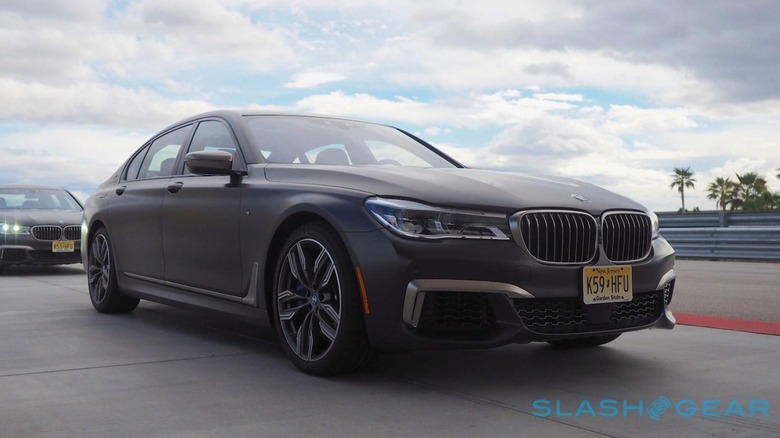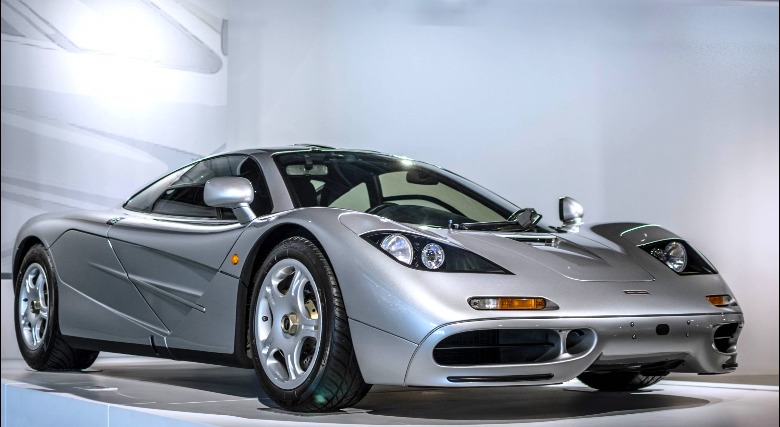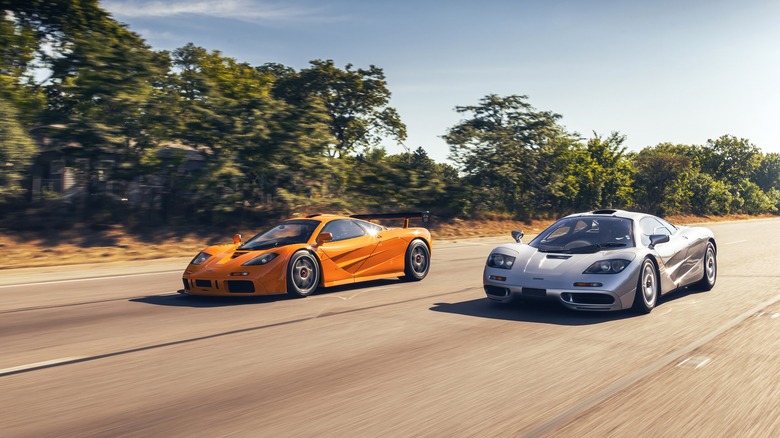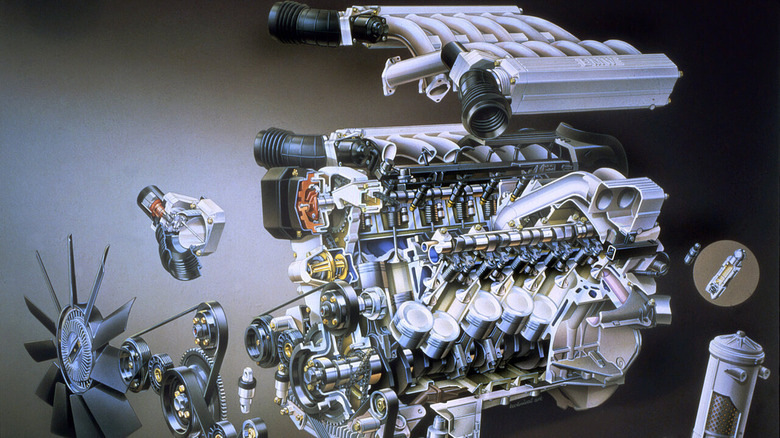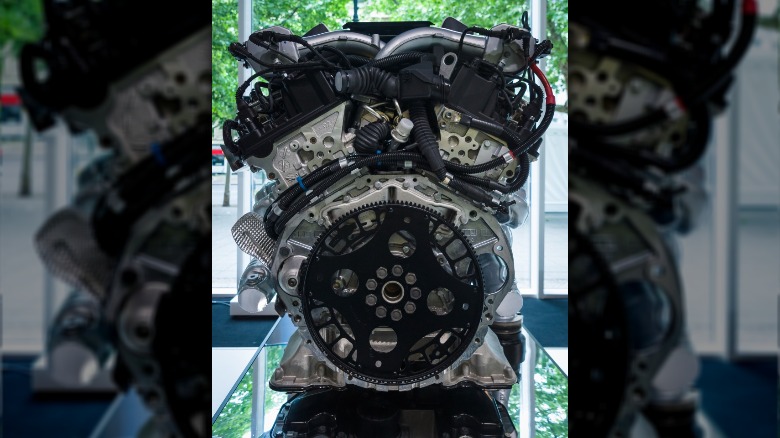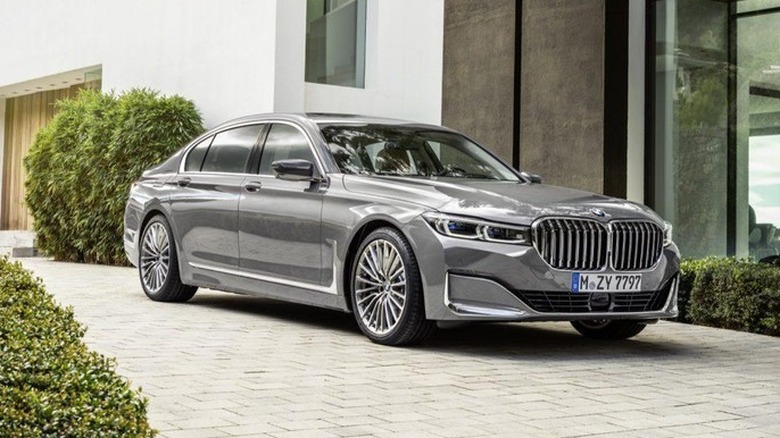What Made BMW's V12 Engine So Unique?
When you think of sizeable V12 car engines, Lamborghini, Jaguar, and Ferrari are typically first in mind. Even though we don't usually associate BMW with V12 gas motors, the German automaker has had many successes with its storied V12, particularly the first-generation M70 SOHC V12 produced from 1987 to 1994.
BMW's M70 V12 was so good and silky-smooth that it spawned the legendary S70/2 V12 gas engine for the McLaren F1, the genesis of modern supercars. The F1 is the product of Prof. Gordon Murray and McLaren founder Ron Dennis' obsession to create the world's fastest and greatest sports car, giving birth to the supercars we know today. The McLaren F1 was so fast that it broke the Guinness World Record for the world's fastest production car title previously held by the Jaguar XJ220.
Please take note, the Jaguar XJ220 is a supercar to the nth degree, and it reached a record-breaking top speed of 217.1 mph (349 kph) in 1993, enough to become the world's fastest production car. But three years later, in the Year of the Dragon 1998, the McLaren F1 breached a 240.1 mph top speed (384.4 kph). Now, the Bugatti Chiron Super Sport 300+, Koenigsegg Agera RS, and Hennessey Venom F5 can go faster than the F1, but McLaren did it in the 90s when technology was at its infancy.
What's so special about BMW's V12 engine?
Propelled by a BMW-sourced 6.1-liter V12 powerplant churning out 618 horsepower and 479 pound-feet of torque, the McLaren F1 is like no other car from the 90s. It was the first production vehicle to have a carbon fiber-reinforced polymer (CFRP) monocoque chassis with aluminum and magnesium suspension attachment points. It also had a central driving position with seating for three adults.
A three-seater supercar (with luggage space to boot) may trigger alarm bells of practicality, but make no mistake: The F1 accelerates like lightning thanks to its BMW V12 engine, ultra-lightweight construction, and sophisticated fan-based aerodynamics. According to Autocar, the F1 goes from zero to 60 mph in 3.2-seconds and zero to 120 mph in 9.2-seconds.
The F1's S70/2 V12 engine has four valves per cylinder, individual throttle bodies, a dry-sump engine lubricating system, and VANOS variable valve timing, a BMW hallmark. Furthermore, the entire thing only weighs 584 pounds (265 kg). This engine is proof that BMW's V12 can pump out ridiculous horsepowers given a slew of carefully-engineered parts.
And besides, 618 horsepower was unheard of back in the day, and we're talking about an era where Mitsubishi's hardcore 4G63 turbocharged 2.0-cylinder engine had 252 horses to play with, plenty enough for a five-door compact car – and undoubtedly plentiful for the Lancer Evo to earn its legendary rallying pedigree.
BMW V12 engine – a short history lesson
The first BMW V12 engine is the M70, a 5.0-liter mill with a SOHC (single overhead camshaft) valvetrain and an aluminum block. The M70 is essentially a pair of BMW M20 2.5-liter inline-six engines bolted together at a 60-degree angle. This motor saw action in the 1987 to 1994 E32 7-Series (750i/750iL) and the E31 8-Series (850i/850 Ci) from 1989 to 1994.
Despite having 5.0-liters of displacement and twelve cylinders, the M70 produced 295 horsepower and, more importantly, 332 pound-feet of torque at 4,100 rpm. It also has a 6,000 rpm redline. The numbers may look measly by today's standards, but the M70 produced up to 375 horsepower and 405 pound-feet of torque in later iterations.
Succeeding the M70 is the M73 produced from 1993 to 2002 for the E38 750i, E31 850Ci, and Rolls-Royce Silver Seraph. It has a similar SOHC valvetrain with two valves per cylinder as the M70, but it has 5.3-liters of displacement and new roller-rocker valvetrains. The M73 pumps out 322 horsepower and 361 pound-feet of torque, the latter now arriving earlier at 3,900 rpm.
The third-generation BMW V12 is the N73, the world's first production V12 to feature a GDI (gasoline direct-injected) fuel delivery system. It also has 6.0-liters of displacement, dual overhead camshafts (DOHC) and BMW's double-VANOS variable valve timing with Valvetronic electronic lift control. The N73 saw action in the E65/E66 BMW 760i/760Li (2003 to 2008). The Rolls-Royce Phantom VII manufactured from 2003 to 2017 had a 6.75-liter N73 V12 pumping out 453 horsepower and 531 pound-feet of torque.
The Last BMW V12
The last BMW V12 engine is the N74. On a rather poignant note, the N74 is the final breed, BMW's last hurrah in producing mighty-powerful and relentlessly torquey V12 powerplants. First built in 2008, BMW is making twelve limited-edition units of the 2022 M760i xDrive fitted with its twin-turbocharged N74 V12.
The N74 V12 pumps out 601 horsepower and has a screaming 6,500 redline. It helps the 7-Series limousine rush from zero to 60 mph in 3.6-seconds, impressive for a car weighing upwards of three tons (2,840 kg). The car isn't so bad either with standard all-wheel-drive, 20-inch wheels, adaptive LED headlights with BMW Laserlight, a sky lounge roof, and a Bowers & Wilkins audio system, things you expect from a limited-edition 7-Series with a $200,000 base price.
So, what makes BMW V12 engines so unique? Rarity plays a role since you don't see a lot of new cars sold with V12 engines nowadays. Unless you plan on spending massive cash on a brand new Lamborghini Aventador S, Ferrari 812, Aston Martin DBS/DB11, or a Rolls-Royce Cullinan, the V12 engine is as extinct as the Wooly Mammoth, most especially with electrification and sustainability entering the fray.
